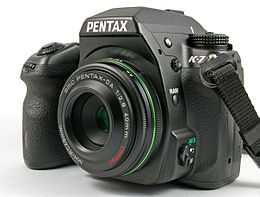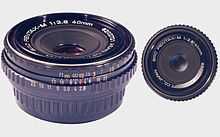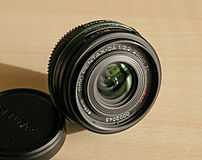Pancake lens

A pancake lens is colloquial term for a flat, thin lens (short barrel), generally a normal or slightly wide prime lens for a camera.
Motivation
Pancake lenses are primarily valued for providing quality optics in a compact package. The resulting camera and lens assembly may even be small enough to be pocketable, a design feature which is usually impractical with conventional SLR bodies and lens assemblies. Pancake lenses can be very short and flat because they do not need large amounts of optical correction, i.e. extra lens elements. The problem arises when such lenses have too short a focal length to fit in front of the retractable mirrors used in reflex cameras. In such a situation a pancake lens focuses in front of, rather than on, the focal plane (film or light sensor) of the camera. This has necessitated the design of retrofocus lenses that refocus the image further back, which is why such lenses are longer and bulkier than their "pancake" equivalents.
History
An early example is the (Zeiss) Tessar of 1902.
In the 1960s and 1970s the Nikon GN lens was a notable example, while in the 1970s and 1980s pancake lenses were used in compact single lens reflex (SLR) cameras.[1]
The design has seen a resurgence due to the growth of the mirrorless interchangeable-lens digital camera market, notably the Micro Four Thirds system.
-
.jpg)
Canon EF 40mm f/2.8 STM pancake lens
-

SMC Pentax-M 40 mm
-

Pentax DA 1:3.2 21 mm
See also
References
- ↑ DPReview forum: Re: Why is a pancake lens a big deal?, Photomonkey, 10:01:14 PM, Thursday, September 14, 2006